
Hypericaceae is a plant family in the order Malpighiales, comprising six to nine genera and up to 700 species, and commonly known as the St. John's wort family. Members are found throughout the world apart from extremely cold or dry habitats. Hypericum and Triadenum occur in temperate regions but other genera are mostly tropical.

Cyclanthaceae is a family of flowering plants.

The Molluginaceae are a family of flowering plants recognized by several taxonomists. It was previously included in the larger family Aizoaceae. The APG III system of 2009 made no change in the status of the family as compared to the APG II system of 2003 and the APG system of 1998, apart from a reassignment of several genera, such as the placement of Corrigiola and Telephium into Caryophyllaceae, Corbichonia in Lophiocarpaceae, Microtea into Microteaceae and Limeum in Limeaceae, because the family was found to be widely polyphyletic in Caryophyllales. In addition Macarthuria was found not to be related to Limeum as previously thought and thus it was placed in Macarthuriaceae, and similarly species formerly placed in Hypertelis, apart from type species Hypertelis spergulacea, a true Molluginaceae, were found to belong elsewhere and were described as Kewa in the family Kewaceae, named for the Royal Botanic Gardens Kew. Molluginaceae is still assigned to the order Caryophyllales in the clade core eudicots, although the generic circumscription is difficult because Mollugo is not monophyletic.
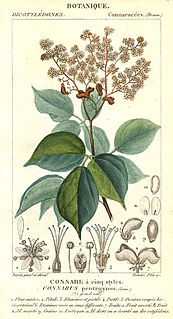
Connaraceae is a pan-tropical plant family of 19 genera and more than 180 species of largely evergreen trees, woody shrubs and climbers.

Desmoncus is a genus of mostly climbing, spiny palms native to the Neotropics. The genus extends from Mexico in the north to Brazil and Bolivia in the south, with two species present in the southeastern Caribbean.
Nothofagus nuda is a species of plant in the family Nothofagaceae. It is endemic to Papua New Guinea. It is threatened by habitat loss. N. nuda proposed to be renamed Trisyngyne nuda in 2013.

Thismia is a genus of myco-heterotrophic plants in family Burmanniaceae, first described as a genus in 1845. It is native to East and Southeast Asia, New Guinea, Australia, New Zealand, and the Americas.

Pholidostachys is a genus of palms found in Central America and northwestern South America.
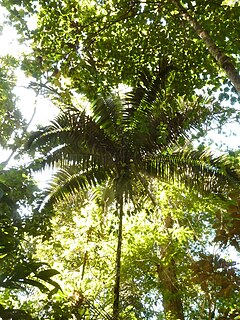
Welfia is a genus of palms found in Central America and northwestern South America. Only two species are currently recognized: Welfia regia and Welfia alfredii.

Anisomeridium is a genus of lichens in the family Monoblastiaceae. The type species was originally named Arthopyrenia xylogena by Swiss botanist Johannes Müller Argoviensis in 1883; in 1928, Maurice Choisy defined the genus Anisomeridium, designating A. xylogena the type species.
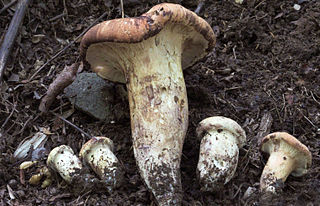
Gloeocantharellus is a genus of fungi in the family Gomphaceae. It contains 12 species that are found in mainly tropical and subtropical regions.

Taeniatherum is a genus of Eurasian and North African plants in the grass family known by the common name medusahead.

Multiclavula is a genus of basidiolichens in the family Hydnaceae. The widespread genus contains 14 species.

Gliophorus is a genus of agaric fungi in the family Hygrophoraceae. Gliophorus species belong to a group known as waxcaps in English, sometimes also waxy caps in North America or waxgills in New Zealand. In Europe, Gliophorus species are typical of waxcap grasslands, a declining habitat due to changing agricultural practices. As a result, two species, Gliophorus europerplexus and Gliophorus reginae, are of global conservation concern and are listed as "vulnerable" on the IUCN Red List of Threatened Species.
Trichocentrum silverarum is a type of orchid native to Panama. It was named after its discoverers, Gaspar Silvera and his daughter Katia Silvera. Originally described as Lophiaris silverarum, it is now placed within Trichocentrum.
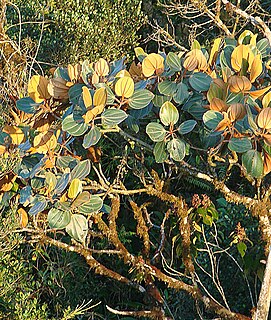
Graffenrieda is a genus of flowering plants in the family Melastomataceae. There are about 44 species. Most occur in South America. A few are distributed in Mexico, Central America and the Caribbean.
Fomitopsis subfeei is a species of polypore fungus in the family Fomitopsidaceae. Found in southern China, it was reported as new to science in 2014 by mycologists Mei-Ling Han and Bao-Kai Cui. Characteristics of the fungus include perennial, effused-reflexed to pileate fruit bodies, a concentrically grooved cap surface, and a pinkish-brown to vinaceous-brown pore surface on the cap underside. Microscopic characters include spindle-shaped cystidioles, and small, oblong-ellipsoid spores measuring 4–5 by 1.9–2.5 μm. The fungus causes a brown rot on gymnosperms.
Postia duplicata is a species of poroid fungus in the family Fomitopsidaceae that was described as a new species in 2014. It is found in Yunnan and Zhejiang provinces of China, where it causes a brown rot on angiosperm wood. The fungus is named (duplicata) for its characteristic two-layered context, a feature that distinguishes it from other Postia species. The spores made by this fungus are cylindrical, hyaline, smooth, and typically measure 3.8–5.8 by 1.8–2.5 µm.
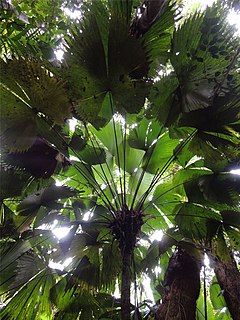
Sabinaria magnifica is a species of palm tree and the only member of the genus Sabinaria. Native to the Darién Gap on the border between Colombia and Panama, it grows from 1 to 6 metres tall with large, deeply-divided leaf blades. It has been described as "striking", "spectacular" and "beautiful" by taxonomists.
The Philippine Taxonomic Initiative (PTI) is a private Philippine research institute and non-profit organization founded in 2018, located in the Philippines.














